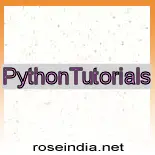Python Tutorial
- Instant Python
This is a minimal crash-course in the programming language Python. To learn more, take a look at the documentation at the Python web site, www.python.org; especially the tutorial. If you wonder why you should be interested, check out the comparison page where Python is compared to other languages. This introduction has been translated into several languages, among them Portuguese, Italian, Spanish, Russian, French, Lithuanian, Japanese, German and Greek, and is currently being translated into Norwegian, Polish, and Korean. Since this document still might undergo changes, these translations may not always be up to date.
- Non-Programmer's Tutorial For Python
So, you've never programmed before. As we go through this tutorial I will attempt to teach you how to program. There really is only one way to learn to program. You must read code and write code. I'm going to show you lots of code. You should type in code that I show you to see what happens. Play around with it and make changes. Now, on to more important things. In order to program in Python you need the Python software. If you don't already have the Python software go to http://www.python.org/download/ and get the proper version for your platform. Download it, read the instructions and get it installed.
- Python Tutorial
If you ever wrote a large shell script, you probably know this feeling: you'd love to add yet another feature, but it's already so slow, and so big, and so complicated; or the feature involves a system call or other function that is only accessible from C ...Usually the problem at hand isn't serious enough to warrant rewriting the script in C; perhaps the problem requires variable-length strings or other data types (like sorted lists of file names) that are easy in the shell but lots of work to implement in C, or perhaps you're not sufficiently familiar with C.
Another situation: perhaps you have to work with several C libraries, and the usual C write/compile/test/re-compile cycle is too slow. You need to develop software more quickly. Possibly you've written a program that could use an extension language, and you don't want to design a language, write and debug an interpreter for it, then tie it into your application.
- The LiveWires Python Course
The LiveWires Python Course is intended to teach the Python programming language to people who have never programmed before.
The current LiveWires Python Course release is release 1.2. The current LiveWires package release is release 2.0. The major change from previous versions is the use of the Pygame library for the games worksheets.
Learning Python: PDF worksheets and LiveWires package
Development: LaTeX worksheets and LiveWires package source
LiveWires: credits and feedback and redistribution licence
Older material: Python for the impatient and inexperienced
- Python Bibliotheca
This site aims to be both a library of educational materials using Python to teach computer programming, and a virtual meeting place for teachers and students engaged in learning and teaching using Python.So come on in, poke around, feel free to take whatever you find useful (everything here is free!), and if you feel the urge, get involved and contribute as well.
- Python v1.5 Library Module Quick Reference
The ``Python library'' contains several different kinds of components. It contains data types that would normally be considered part of the ``core'' of a language, such as numbers and lists. For these types, the Python language core defines the form of literals and places some constraints on their semantics, but does not fully define the semantics. (On the other hand, the language core does define syntactic properties like the spelling and priorities of operators.) The library also contains built-in functions and exceptions -- objects that can be used by all Python code without the need of an import statement. Some of these are defined by the core language, but many are not essential for the core semantics and are only described here.
- CGI in Python
Python provides a portable, interpreted, interactive, object-oriented programming (OOP) language ideal for Common Gateway Interface (CGI) Web programming. Furthermore, its pairing of significant power and clear syntax makes Python an excellent instructional tool. Language features include modules, classes, very high level dynamic data types, and dynamic typing. The objective of this site is twofold: introduce new Python programmers to the core language and provide new CGI programmers with a conceptual CGI knowledge base through the use of Python. This site best suits programmers with an intermediate level (two years or more) of object oriented C++ or Java programming experience.
- Python for Science
My main use of Python is computational science, and more specifically computational chemistry. In the course of many Python projects, I have accumulated some code of general use, which I make available to the public here. Most of this code uses the numerics extension (aka NumPy). If you want to use these modules, you have to get and install NumPy first (do it, it's easy). Following the Python tradition, I provide my code for free and without any guarantee. I welcome bug reports and suggestions for improvements.



